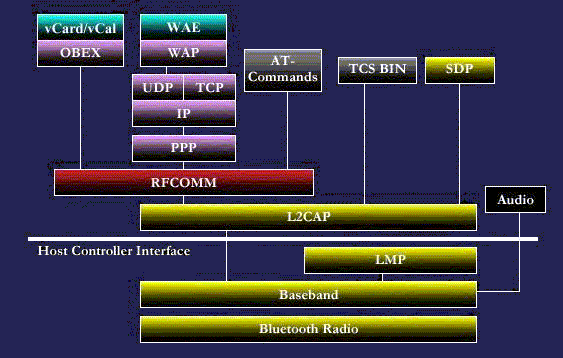You are here
Protocol Stack
The Bluetooth Special Interest Group (SIG) has developed the Bluetooth Protocol Stack. These specifications allow for developing interactive services and applications over interoperable radio modules and data communication protocols. Given below is an overview of the protocols in the specification.
The main objective of these specifications is to set down the protocols that must be followed by companies when manufacturing and developing both software and hardware to interoperate with each other. To achieve this interoperability, matching applications (e.g., corresponding client and server application) in remote devices must run over identical protocol stacks.
Different applications may run over different protocol stacks however they will all have one imperative factor that will allow them to be interoperable and that will be the use of a common Bluetooth data link and physical layer. The complete Bluetooth protocol stack is shown in figure below. It may seem that an application must use all protocols shown however not all applications will make use of all the protocols shown. Instead, applications run over one or more vertical slices from this protocol stack.
The main principle in mind when developing the Bluetooth Protocol Architecture has been the maximization and the re-use of existing protocols for different purposes at the higher layers. The one main advantage is that existing (legacy) applications can be adapted to work with the Bluetooth Technology. The Bluetooth Protocol Architecture also allows for the use of commonly used application protocols on top of the Bluetooth-Specific protocols. In simpler terms, this permits new applications to take full advantage of the capabilities of the Bluetooth technology and for many applications that are already developed by vendors; they can take immediate advantage of hardware and software systems, which are also compliant with the Specification.

Fig 1:The Bluetooth Protocol Stack Model
The protocols and layers in the Bluetooth protocol stack
| Protocol Layer | Protocols in the stack |
| Bluetooth Core Protocols | Baseband, LMP, L2CAP, SDP |
| Cable Replacement Protocol | RFCOMM |
| Telephony Control Protocol | TCS Binary, AT-commands |
| Adopted Protocols | PPP, UDP/TCP/IP, OBEX, WAP, vCard, vCal, IrMC, WAE |
In addition to the above protocol layers, the Specification also defines a Host Controller Interface (HCI). This provides a command interface to the baseband controller, link manager, and access to hardware status and control registers.
The Bluetooth Core protocols (plus the Bluetooth radio) are required by most of Bluetooth devices while the rest of the protocols are used only as needed. The combination of the Cable Replacement layer, the Telephony Control layer and the adopted protocol layer form the application-oriented protocols which enable applications to run over the Bluetooth Core protocols.
The Bluetooth Protocol Architecture has been developed by the Bluetooth Special Interest Group (SIG) are intended for rapidly developing applications using Bluetooth technology. The lower layers of the Bluetooth stack are designed to provide a flexible base for further protocol development. RFCOMM protocols are adopted from existing protocols and these protocols and have been only slightly modified for the purpose of Bluetooth. The upper layer protocols are used without modifications this has been to allow existing applications to be reused to work with the Bluetooth technology and the interoperability is ensured more easily.
